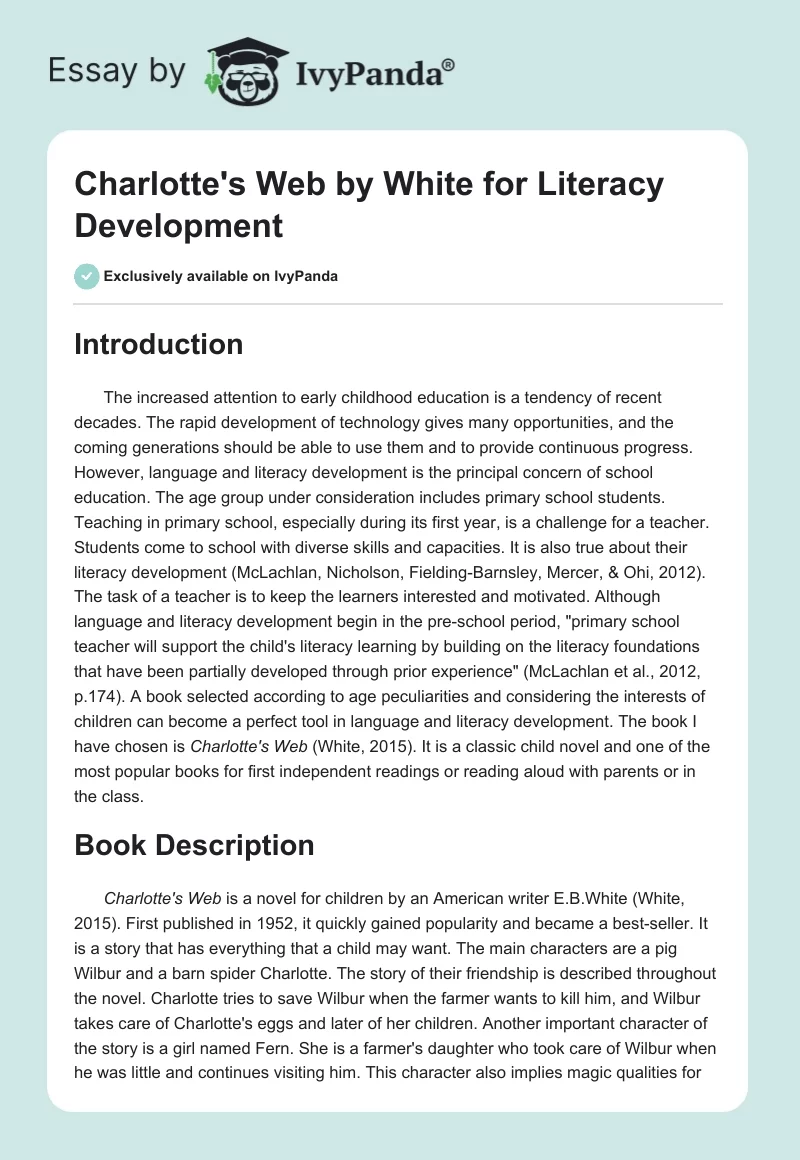Introduction
The increased attention to early childhood education is a tendency of recent decades. The rapid development of technology gives many opportunities, and the coming generations should be able to use them and to provide continuous progress. However, language and literacy development is the principal concern of school education. The age group under consideration includes primary school students. Teaching in primary school, especially during its first year, is a challenge for a teacher. Students come to school with diverse skills and capacities. It is also true about their literacy development (McLachlan, Nicholson, Fielding-Barnsley, Mercer, & Ohi, 2012). The task of a teacher is to keep the learners interested and motivated. Although language and literacy development begin in the pre-school period, “primary school teacher will support the child’s literacy learning by building on the literacy foundations that have been partially developed through prior experience” (McLachlan et al., 2012, p.174). A book selected according to age peculiarities and considering the interests of children can become a perfect tool in language and literacy development. The book I have chosen is Charlotte’s Web (White, 2015). It is a classic child novel and one of the most popular books for first independent readings or reading aloud with parents or in the class.
Book Description
Charlotte’s Web is a novel for children by an American writer E.B.White (White, 2015). First published in 1952, it quickly gained popularity and became a best-seller. It is a story that has everything that a child may want. The main characters are a pig Wilbur and a barn spider Charlotte. The story of their friendship is described throughout the novel. Charlotte tries to save Wilbur when the farmer wants to kill him, and Wilbur takes care of Charlotte’s eggs and later of her children. Another important character of the story is a girl named Fern. She is a farmer’s daughter who took care of Wilbur when he was little and continues visiting him. This character also implies magic qualities for she is the only person in the novel who understands the nonhuman language. The book can be used in different aspects of the educational process such as moral issues or the topic of friendship. I suggest using it as a basis for literacy strategies aimed at language and literacy development in primary school.
Literacy Strategies
In primary school children already have some literacy skills. Thus, the strategies applied should be oriented to further language and literacy development (McLachlan et al., 2012). Vocabulary enhancement is among the main strategies. Charlotte’s Web is a book with many challenging words. Guess the meaning and fill-in activities may be fruitful here. Another engaging activity is a word search that can be designed in the shape of a web. One more aspect of vocabulary enhancement can be an adjective game aimed at describing the main characters. Since the book is divided into chapters, there will not be many new words in each of them; thus the learning will not be tiring.
Another strategy applied with primary school students is the comprehension of what was read (McLachlan et al., 2012). It implies not only the understanding of the story but also reproducing the content. The activities appropriate with this strategy can be a retelling, discussion, or role-play. As a rule, primary school students of second and third years can write. Thus a written comprehension is possible. It teaches the students to express themselves both orally and in writing.
One more strategy that may be effective includes phonological awareness activities. It makes the children get acquainted with the sounds of a language. The activities that imply phonological awareness comprise listening to the stories, songs, or poems, and participating in games. The methods mentioned above should include tasks on sound matching, rhyme, and alliteration. Such activities combine a game with learning. About Charlotte’s Web, imitating animals or guessing their voices can be included as a phonological activity.
The Use of Strategies for Learners with Language Deficiencies
Language deficiencies are usually revealed during childhood. Often with the appropriate training, they can be minimized or corrected. Anyway, children with specific language impartments need much attention (Leonard, 2013). The strategies mentioned in the previous part of the paper can be successfully applied to learners with language deficiencies. Vocabulary enhancement can be done through matching activities. At first, children can match the words they hear with the pictures, later the images of words can be added. For example, children with dyslexia may find interesting matching the words with the pictures thus uniting both the word image and the corresponding illustration. It is crucial to evaluate the appropriateness of the task to the specific deficiency. The comprehension check can also be provided through visual materials, for example ordering the pictures chronologically. Phonological awareness activities based on the book may include sound imitation. Anyway, the teacher needs to adapt the tasks to make them adequate to the children’s abilities.
Conclusions
On the whole, literacy and language development is a complicated process. It may seem natural, but it will not be effective without appropriate guidance. It demands particular attention in primary school since it has to become an instrument of further learning. Thus, effective education strategies are the key to further success in literacy and language development.
References
Leonard, L.B. (2013). Children with specific language impairment (2nd ed.). Cambridge, MA: The MIT Press.
McLachlan, C., Nicholson, T., Fielding-Barnsley, R., Mercer, L., & Ohi, S. (2012). Literacy in early childhood and primary education: Issues, challenges, solutions. New York, NY: Cambridge University Press.
White, E.B. (2015). Charlotte’s web. New York, NY: Harper & Row, Publishers.


